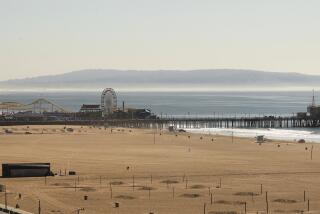Santa Monica OKs Hotel Complex : Developers to Pay $1 Million for Improvements, Licenses
- Share via
The Santa Monica City Council last week overruled the city Planning Commission and approved a new $55-million beachfront hotel complex.
The 6-1 council vote to approve the proposed 196-room hotel at 100 Pico Blvd. came despite residents’ objections that the hotel will increase traffic congestion and ruin their residential neighborhood, and the Planning Commission’s rejection of the project in October.
The three-building complex on 1.5 acres will have two beachfront buildings and a third building east of Appian Way. A pedestrian walkway above Appian Way will connect the buildings, according to Mark Solit, developer and spokesman for property owner Sam Stein of R. E. International Investments.
Paying for Improvements
Stein and Solit will pay the city more than $1 million for beach-area improvements and for use of streets adjacent to the hotel, Solit said.
One of the Planning Commission’s concerns was that the development did not meet city land-use requirements. In order to expand the project’s property size and conform to city regulations, the City Council is allowing the developers to include part of Pico Boulevard and the air space above Appian Way as hotel property.
In exchange, Solit and Stein have agreed to maintain those portions of the streets and to pay the city about $553,000 in license fees, Solit said.
“They (the developers) bought the city out,” charged Anne Sterman, owner of the 13-room Drake Hotel behind the proposed complex. “These are public streets and they are being given away.”
Solit said: “We are paying so we can build a public park.” The hotel plans include a small public park on Pico Boulevard and a stairway to the beach.
Increased Contribution
The developers also increased their contribution for improvement of the public beach area from $280,000 to $540,000, Solit said. The improvements will include repavement of the Promenade and acquisition of a fountain or sculpture for the Pico Boulevard park, he said.
The developers will work with the Santa Monica Arts Commission and the Arts Foundation to select an artist to design the project, he said.
City Councilman David Finkel, the only council member to vote against the project, said: “It is not a nice project. The area is predominantly residential, and the residents don’t want it (the hotel).”
The councilman, who is philosophically opposed to rapid development, said the city’s land-use regulation was intended to slow down this type of commercial development. “It is not working,” he said, “and I’m worried about what this community will be like in a decade.”
The project now faces scrutiny from the California Coastal Commission. Although the hotel plans have not been submitted to the commission, Teresa Henry, commission planning supervisor, said the size of the project would probably not present a problem.
Impact on Beaches
The commission’s primary concern, Henry said, is to protect and enhance visitor use of the beaches.
The commissioners will look closely at the hotel’s impact on pedestrian and automobile traffic, public parking, and any landscaping that would give the perception of private encroachment on the beach area, Henry said.
The city’s decision to allow the hotel developers to use public street areas is a local issue, unless the design inhibits public use of the street or is perceived by the public to be private property, Henry said.
Plans for the hotel call for two beachfront buildings with indoor and outdoor dining facilities, meeting rooms, banquet facilities and a small ballroom.
A six-story building across Appian Way would contain most of the 196 guest rooms and parking for 496 automobiles, Solit said.
Assuming the Coastal Commission approves the project, Solit said the hotel complex, to be called the Santa Monica Beach Hotel, is expected to open on Jan. 1, 1990.
More to Read
Sign up for Essential California
The most important California stories and recommendations in your inbox every morning.
You may occasionally receive promotional content from the Los Angeles Times.













